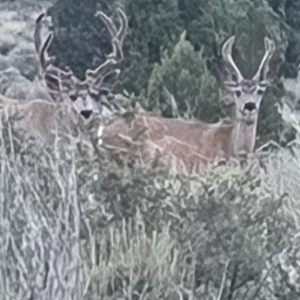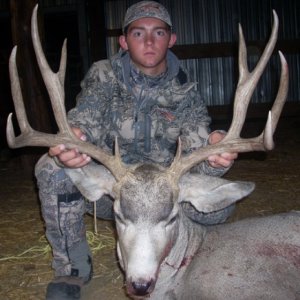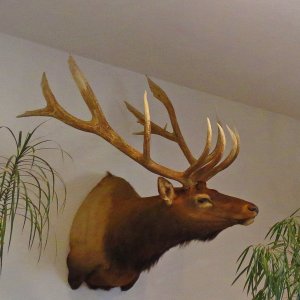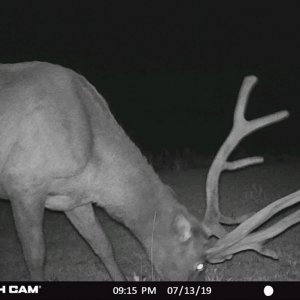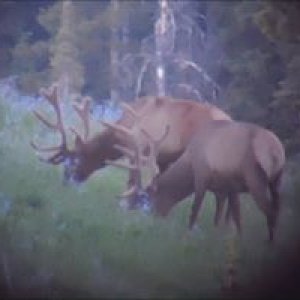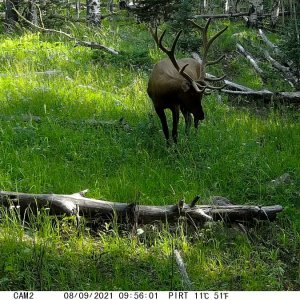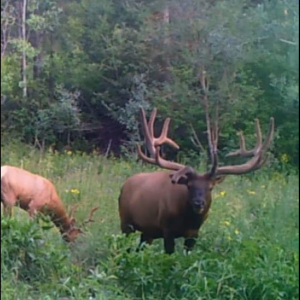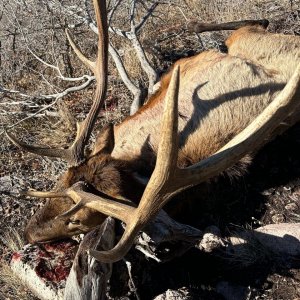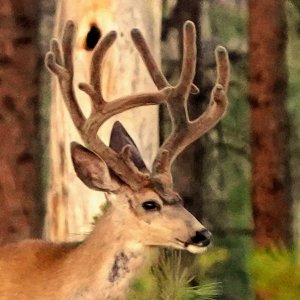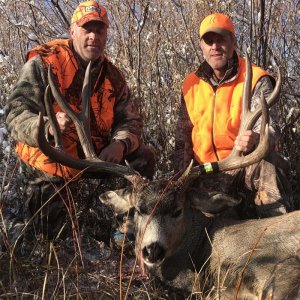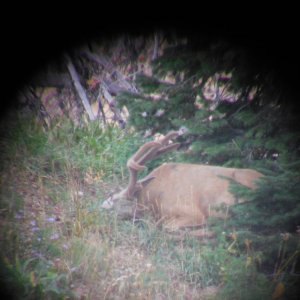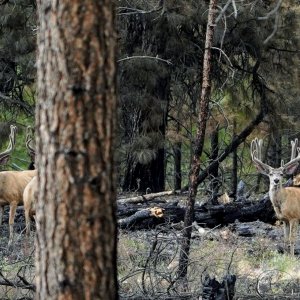LAST EDITED ON Mar-15-10 AT 11:42AM (MST)[p]12 Wicked Tips for Stalking Mule Deer
Cameron Hanes | February 06, 2006
Taken from the pages of my soon-to-be-released book, ?Backcountry Bowhunting: A Guide to the Wild Side.? Part 1 of a 4-installment series.
During my long bowhunting career, I have been lucky enough to hunt some of
the West's best backcountry for trophy mule deer. And in doing so, I have
killed a fair number of 4x4 or better Pope & Young bucks.
Regardless of where I've hunted these tough-to-arrow animals, I have relied on a
dozen tips for success. By keeping the following 12 tips in mind (we'll break them up and distribute them evenly during my four website posts in February) you, too, might lash your tag to the antler of a monster this fall.
1. Stay in the shadows
Sunlight is always the enemy. You can get away with much more movement when you're in the shadows. A glint of sun off your binocular lens or a broadhead, or the flash of the back of your hand, can draw the attention of a wary buck and sabotage your stalk.
2. Be patient and never force a stalk.
Getting aggressive on elk is one thing, getting aggressive on mule deer simply will not work. When in close, taking it slow and staying in control are keys. Mule deer hunting can test
your patience like nothing else can.
I once lay for hours in the blazing sun 20 yards from a big buck, praying for him to stand and expose his vitals. Over this time it was like I formed a silent, one-way bond
with the animal. With an arrow nocked, waiting, I studied every inch of his
rack, every point, knob and burr?watched him roll his head around, shake
off flies and flap his ears.
I would tense up with his every move, thinking, "He is getting up. This is my chance." And then, with one gust of fickle wind my heart and our bond were broken. Nothing hurts as badly as being so close for so long and then having it fall apart. But this intimacy is what makes bowhunting so unique and that hard-earned success so special.
3. Close in only when the wind is steady.
Wait out those switching thermals. The air currents are the worst in midmorning, when the sun warms the mountains. What was once a steady breeze going down becomes unstable,
then begins rising up as the heat of the day builds. I always wait until
the air warms and rises because this compliments another must--you must
come in on your buck from above. This should only be done with the wind
blowing steadily in your face.
4. Come in from above.
A big buck will nearly always bed with his back protected while watching for danger from below. Popping in from above is the No. 1 way a bowhunter can kill a trophy.
5. Use the contour of the land.
On almost all my successful stalks, I executed an approach to get me in the ?red zone? under the shield of cover or land contour, as opposed to moving through the open. Once in range I then popped over a bench, rock ledge, from behind a boulder or whatever, and deftly placed my arrow in the buck's vitals.
12 Wicked Tips for Stalking Mule Deer, Part 2
Cameron Hanes | February 13, 2006
Taken from the pages of my soon-to-be-released book, ?Backcountry Bowhunting: A Guide to the Wild Side.? Part 2 of a 4-installment series.
6. Pick out landmarks.
You must pick out landmarks to guide you in close to a buck. As you move from a mountainside or bluff where you first spotted a buck, everything changes so far as perspective goes.
Many guys locate a buck and start their stalk, but when they get to the other side of a canyon, they loose track of where the deer is bedded. This is the ultimate in
frustration. I've learned the hard way to always take the time to select
distinct landmarks before heading out.
7. During the stalk, check the wind often.
A non-scented powder works well for checking the currents. If the wind gets wacky on you, back out until it stabilizes. You have no room for error on this one. Terrain contour can alter prevailing wind direction a lot.
8. Always assume the buck is still where you last saw him.
Just as soon as you think, "He's gone, I blew him out already" and jump up on a rock to
have a better look around, there he is, still bedded! But guess what? Game?s
over because now he is gone for real.
The size of the country where mule deer live can be very deceiving. After stalking awhile you might think you should be right on top of a buck, but in reality he is a little farther ahead than you anticipated. Be patient and always assume the buck is still there until you know without a shadow of a doubt that he is gone. Remember to pick those landmarks.
9. Choose your battles wisely.
The Nevada buck my buddy South Cox killed in August 2005 is the perfect example of this tip. We had a deer that we named the ?G-4 buck??he was slightly larger than the one South ended up killing?bedded in a spot where a high-percentage stalk was iffy at best. While many hunters probably would have gone after G-4, the chances of success, given where the buck was
bedded and also the proximity of some surrounding deer, made success all but
impossible.
So my buddy went after his second choice?a 5x4?that was in a much
better location for a stalk. South got in tight and got him. Make a good decision in this regard ? a big buck usually only gives you one chance.
10. Wait for the buck to bed.
Other bowhunters might have differing views on this, but all my big mule deer, save one, were bedded when I shot them. Knowing a buck?s exact location is a huge advantage to the
spot-and-stalk bowhunter. I think you're making a big mistake if you take off
after a buck before he beds.
11. Don't get lazy.
Hey, I want success as much and as quickly as the next guy, but taking shortcuts or not going the extra mile sabotages many stalks. It is such hard work even getting into prime mule deer country,
not to mention finally finding a trophy to go after, that you owe it to yourself
to make the most of it.
Keep working hard and the odds of closing the deal increase exponentially. Sometimes it is just a matter of gaining a little more elevation to get the wind right, or dropping down to skirt other deer.
While the shortest distance from point A to point B is a straight line, the
path you take when closing in on a big buck will oftentimes be ripe with
detours. Deal with it.
Don?t get lazy mentally, either.
We bowhunters are slaves to our psyche, which runs the full gamut of emotions, from being overconfident to lacking confidence. My wife, Tracey, claims my psyche includes a touch of obsessive compulsiveness.
With the mind in mind, above all else the #1 key to success is that you have to believe with all certainty that you will make the shot. Many bowhunters, especially new ones, shoot at animals and hope their arrow hits where it is supposed to, whereas when the best hunters loose an arrow and know without a doubt that it will hit spot-on. They?re shocked if for some reason it doesn't.
South Cox displayed this level of brimming confidence on our 2005 Nevada hunt, which I wrote about in last week?s column. He also exhibited a little physiological quirkiness.
Get this?just before beginning the stalk on his big buck, South took a practice shot. His arrow hit so perfectly on the 80-yard poke that he was compelled to put
a new broadhead on that #6 practice arrow, and he used it to kill his buck. South
was so calm and confident in his ability and his equipment that changing out
arrows and broadheads minutes before killing one of his best mule deer on
film was no big thing.
In such a situation, most guys would be battling surging adrenaline and a churning stomach. The last thing on their mind would be messing with their equipment, but South was as cool as the other side of the pillow, and it showed in crunch time.
12. The little things make the difference.
We've all heard this before and most of us have probably said it a time or two, but do we live by it? When hunting mule deer we should. Some little things that come to my mind are:
* put felt on your riser so that an arrow gets knocked off the rest it
doesn't "tink" on the metal riser.
*take off your shoes and finish the stalk in stocking feet when you get into the red zone with a buck.
*dab on a little face paint to avoid "moon face," which is about like a shining a spotlight on a bedded buck if you poke your head up in the sun and he's looking your way.
Treat every stalk like it is your last
I have found myself at the end of a hunt or even at the end of a season, praying for a chance I let get away.
At the beginning of an early-season hunt it is easy to take opportunities for granted, but you need to realize that with mule deer, the hunting almost always gets tougher the longer you go. It is not like the deer are moving toward the peak of the rut or anything. Your repeated presence in an area will educate a big buck and get him on edge, if not blow him out of the high country.
Plus, once that velvet is gone, those older bucks head for the timber. When bowhunting a high-country buck, time is of the essence.
Don?t make eye contact
When in tight on a big buck, never stare him directly in the eye. If he
locks in on you, especially if you're within 50 yards, look down at the ground and try to shield your eyes with the brim of your hat.
Animals are all about body language, as this is largely how they communicate
with each other. If you stare them down, so to speak, I believe this
aggressive, predatory energy is felt, and it will result in a blown stalk.
Stalking Mechanics
When in tight on your target buck, which is sure to be of trophy proportions, you need to take controlled movement to the next level.
It is always a tough call regarding what to do with your bow when slipping in from 40 to 20 yards or even closer. If you are too nonchalant and raise a bow limb above the brush line or in some other manner that catches a buck?s eye, that is obviously not good. There should be no extra movement whatsoever.
Here?s something that works great for restricting bow movement. When you're crawling in a four-point stance and easing in on your target animal, put your bow flat on your back and ease forward, staying as low as possible. It is really not that hard to keep it up there and out of the way. Plus, you are able to use all four appendages for balance as opposed to using one arm to lift and place your bow farther ahead on the path you're taking to the buck.
With your bow out of the way and on your back, it is easier to stay low. You can move forward like a lion, crouched with arms bent the entire time. Also, if you move toward the red zone with your bow in your hand, I guarantee you will inadvertently wave it around a bit. A buck can pick up the flash of that bow in a millisecond.
Another good way to pack your bow is on your lap as you slide downhill toward a buck. It is easy to go slowly on your butt, and movement is minimal. If you get semi-busted in a bad spot, it is easy to drop down on an elbow or completely flat until the buck settles down. The bow has no problem staying balanced in your lap.
I have used this tactic many times over the years. Maybe you will butt-slide in on your next buck?
Failure is a prerequisite
You will not shoot a big buck every time out. In fact, the most successful bowhunters are not those who have never failed, but those who have learned from failure and moved on.
I don't like the feeling of failure?a busted stalk because of my impatience or a clean miss?but I use it as a motivating tool. I take measures to correct my mistakes, and you should too. This is all part of the process. Bowhunting mule deer is tough and will be ripe with failure. The key is
how you respond.
Some great tips from Cameron......I used a majority of them this past year and killed my best buck to date.
Good Luck! Thanks Cam!!
-223

